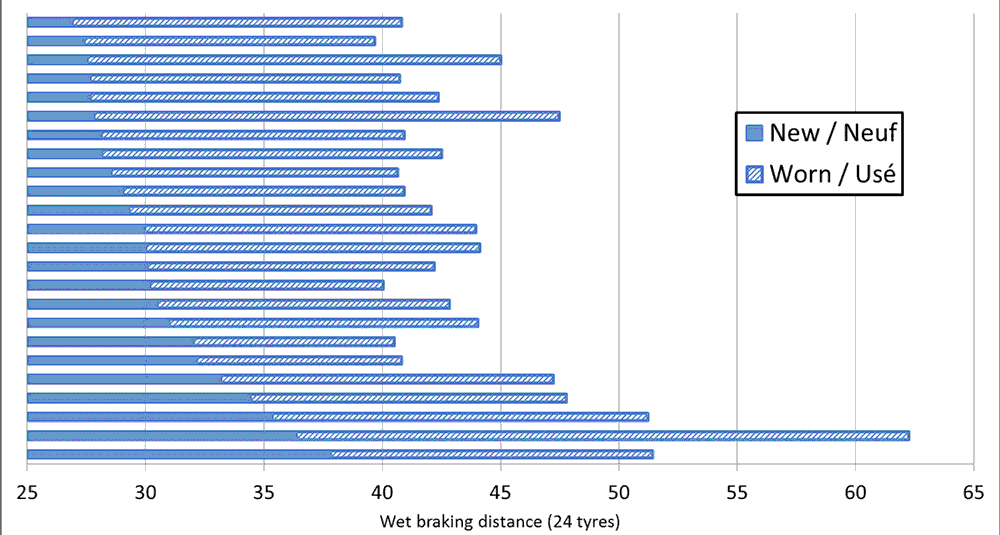In recent months a number of premium tyre manufacturers have reignited campaigns for the minimum tread depth law to be changed from the current 1.6mm, to 3mm.
The logic behind the change in law is sound. Once a tyre reaches 3mm remaining tread depth, the wet braking and aquaplaning performance drops off rapidly, so the message form the tyre companies is understandably about improving the safety of the roads.
The cynic might have another view. By increasing the minimum legal tread depth, tyres will naturally have less life, meaning you'll have to replace tyres more often, meaning the very tyre companies lobbying for the change will sell more products. A little too convenient maybe?
The view from Michelin
Even with the promise of increased sales, Michelin doesn't agree, and they're going to great lengths to explain why. To make their argument, Michelin invited automotive journalist from around Europe to their lead testing facility in Clermont, France to make their case. Their counter arguments are excellent, and cover tyre design, accident data and environmental impacts.
Tyres don't degrade in every performance
The argument to change at 3mm focuses on the loss of wet performance, but in many ways tyres improve with wear.
Dry braking, a key safety quality considering we spend 70% of our time driving on dry roads in the UK, improves due to less block movement. Fuel consumption decreases as there's less material in the tyre to heat up, so you use less fuel, and the tyre is quieter as there's less air being pushed out of the tread blocks, a key cause of noise in tyres.
Changing at 3mm instead of 1.6mm would mean we miss out on the best dry performance of the tyre, the lowest fuel use and the quietest part of its life.
A worn mid range tyre is still better than a new budget during wet braking
Just because a tyre is worn, doesn't mean it's the worst tyre to be using. In a demonstration by Michelin, we drove four identical vehicles, the first with new mid range tyres, the second with worn mid range tyres, the third with new budget tyres, and the fourth with worn budget tyres, and placed them through a wet braking test in 1mm of water from 80 - 20 kph.
The results? The new mid range tyre stopped the car 19.2 meters , the worn mid range tyre 22.1 meters, the new budget tyre 22.7 meters and the worn budget tyre a massive 27.6 meters.
A worn mid range tyre offers similar levels of lateral grip to a new budget tyre
The next demonstration involved a circle skid pan test with 0.8 mm of water, again using a "well regarded midrange brand" scrubbed to 2mm, and a budget tyre at full tread. Driving around the circle, we tracked the peak speed before the car started to understeer obtained on each tyre. The worn midrange and new budget recorded near identical peak speeds, with the worn midrange tyre just ahead at 58 mph compared to 57 mph for the new budget.

There is no link between tread depth and accidents
There have been two major studies showing there's no recorded link between tread depth and accidents. The first, a TNO report for the European Commission in 2014 quoted "The accident data used in the current study however indicates no benefit in terms of reducing the number of accidents by increasing the mimimum tread depth [...] The results of the study suggest that 1.6mm could be a suitable level based on existing national legislation in member states"
The second by VUFO in Dresden, having research traffic accidents for the past 13 years published in their February 16th 2017 newsletter - "In case of an increase of the mimumum tread depth, tires have to be repalced more often. The resulting increase in costs can lead vehicles owners to not invest in tyres with a long term performance due to budget constraints. If tires with a short-term performance are preferred due t ocost considerations this will negatively impact driving and traffic safety"
Tyres are expensive
Another excellent point in the consumers favor is that tyres are an expensive purchase. Due to less block movement and heat build up as tyres wear, tyres wear more slowly as the tread reduces. This means, the 1.4 mm of tread between 3 mm and 1.6 mm is 20% of the tyres life. This means that world wide, consumers would be spending an extra 6.9 billion euros per year.
Environmental impact
So changing at 3 mm instead of 1.6 mm is important for our pockets, but what about the environment? By wearing tyres to the 1.6mm legal limit, instead of 3mm, we would be using 400 million fewer tyres a year, which would save 6.6 million tonnes of CO2, 1/2 yearly co2 of New York, and there would be 35% more tyre waste and raw material use. For all the green efforts of tyre companies, tyres are still a difficult thing to produce and tough on the environment.
What should we do?
The solution favored by Michelin is simple, lets test tyres when worn too. It's easy to make a tyre work well when new, but harder to make a tyre work throughout its tread life, and worn testing would give the customer the best idea of how their chosen tyre will perform throughout the treadlife.
What about aquaplaning, which is most affected by tread depth? When testing a tyre at 2mm, in 1mm of water from 80 - 20 km/h, there's an element of aquaplaning incorporated into the tests as you'll be aquaplaning at the start of the braking phase, so it gives a good overview of how a tyre works in both disciplines.
By leaving the law at 1.6mm and testing worn tyres, we are giving the consumer the knowledge to make their own choice about when to change their tyres.
Now it's just up to the testers.





